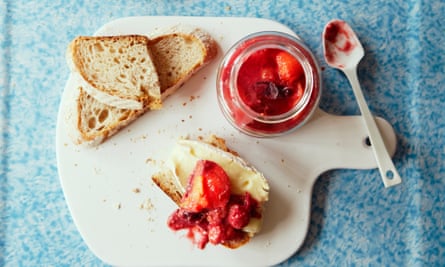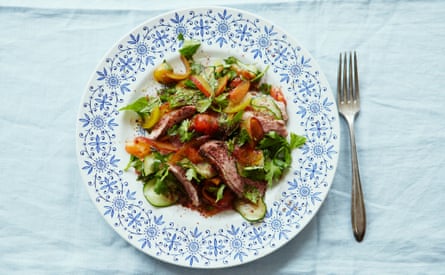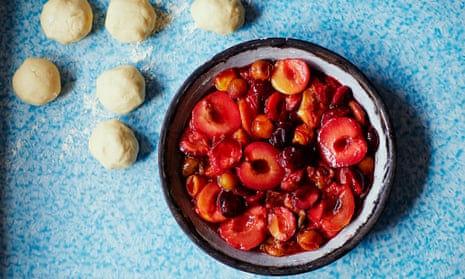The plum comes in a mind- boggling number of colours, from yellow to green to purple (not forgetting the Victoria plum, which is green and purple), all with their own characters and flavours. What unites them is that distinctive sweet tang and their irrepressible juiciness. Their juice needs to be harnessed, for as soon as plums begin to cook, the juice tends to engulf everything. Roasting them first is the solution to this, as you can drain off the juices (set aside for cocktail-making), which concentrates their sweetness beautifully.
Use any plums you can get your hands on – a mix of colours always looks particularly pretty, but any will do. These only get better after a few days resting in the fridge, so we advise working through these recipes at a leisurely pace.
How to roast your plums
If your plums are a little under-ripe, you may want to add a bit more sugar.
2kg mixed plum varieties, halved and stoned, 3 reserved for the duck salad
150g caster sugar
1 Preheat oven to 200C/400F/gas mark 6. Toss the plum halves with the sugar and place, cut-side up, in a single layer in a roasting tray. Roast for 25-30 minutes until the plums are soft, burnished and on the verge of breaking down. Leave to cool before using, making sure you reserve all cooking juices for the mostarda.
The generous pudding: Plum and nutmeg cobbler (pictured above)
This is a brilliant recipe to have up your sleeve, as it takes little effort or skill, and the results are always delicious. The juicy, tangy plums with the sweet, scone-like batter is a killer combo.
Serves 6
100g butter, softened
125g caster sugar
250g plain flour, plus extra for dusting
½ tsp baking powder
A pinch of salt
100ml milk
600g roasted plums
1 nutmeg, grated
1 egg, beaten
Icing sugar, to dust
1 Preheat the oven to 180C/350F/gas mark 4. Make the cobbler dough first by creaming the butter and sugar together with a hand mixer (or by hand) until pale and fluffy.
2 Sift the flour, baking powder and a pinch of salt over the mixture and fold it in with a little of the milk until well-combined. Slowly incorporate the rest of the milk until the mixture becomes a smooth, sticky dough.
3 Put the roasted plums in a dish that holds the plums snugly, and grate generously with the nutmeg.
4 Flour your hands and divide the cobbler dough into about 8 balls. Flatten slightly and place on top of the plums. Brush the dough with the beaten egg, then put in the oven for 35-40 minutes until golden brown.
5 Dust with a little icing sugar, then serve while still warm, with vanilla ice-cream, custard or double cream.
The condiment: Plum mostarda
This is probably what you’d call an Italian chutney, as it has that characteristic spicy sweet and sour taste. Try it with leftover cold meats, with terrines or pâtés, or in your cheese sandwich.

Makes 500ml
500g roasted plums
A small thumb of ginger, peeled and grated
1 tbsp mustard powder
2 tbsp white wine vinegar
1 tsp yellow mustard seeds
1 Drain the plum roasting juices into a saucepan. Bring to the boil, then reduce to a simmer. Combine the grated ginger, mustard powder and white wine vinegar and stir this into the syrup, followed by the reserved fruit. Stir gently to combine and allow the mix to simmer gently for 10 minutes, stirring occasionally.
2 Taste, add a little more vinegar if you want a little more bite, then stir in the mustard seeds.
3 Leave the mostarda to cool, spoon it into a sterilised jar, then cover tightly. It lasts at least a month in the fridge.
The autumn salad: Lebanese seven-spice roasted duck with plum salad
This is one of our favourite spice mixes as it immediately gives your food an injection of warmth. Use it in any Middle-Eastern lamb or beef dishes. It’s especially good with kofte and rubbed into rich duck breasts.

Serves 4-6
For the spice mix
1 tbsp allspice seeds
1 tbsp black peppercorns
1 tbsp coriander seeds
1 tbsp cumin seeds
1 tsp cloves
1 nutmeg, ground
½ tbsp ground cinnamon
For the salad
2 heaped tsp spice mix (above)
3 tbsp extra virgin olive oil
A large pinch of salt
2 duck breasts
3 raw plums, thinly sliced
6 roasted plum halves, sliced in half
1 small cucumber, thinly sliced
1 large handful parsley leaves, roughly chopped
1 large handful mint leaves, roughly chopped
1 large handful coriander leaves, roughly chopped
A large pinch of sumac, plus extra to serve
A squeeze of lemon
1 Make the seven-spice mix first. In a spice grinder or pestle and mortar, grind all the whole spices individually, then mix them in a bowl along with the cinnamon and ground nutmeg. You will make more than enough for this recipe so keep the remainder in an air-tight container for another day.
2 Preheat the oven to 180C/350F/gas mark 4. Combine the spice mix with 2 tbsp olive oil and a good pinch of salt, and rub well into the duck breasts, covering both the skin and the flesh.
3 Place the duck breasts skin-side down into a cold, ovenproof frying pan and place it over a medium-high heat. Leave to cook for a few minutes to allow the fat to render out of the skin.
4 Meanwhile, in a large mixing bowl, gently combine the raw and roasted plums, cucumber and herbs. Then dress with a pinch of sumac, the remaining 1 tbsp olive oil and a squeeze of lemon juice. Season to taste, adding a little more the juice or oil if needed.
5 By now, the duck skin should be golden and should have rendered most of its fat. If not, leave to fry for a further minute or two until the desired colour is reached. Turn the duck over and place in the oven for 6 minutes.
6 Remove the duck from the oven and leave to rest for 6 minutes. Arrange the plum salad on a large platter or plates. Thickly slice the duck and sit it on top of the salad. Finish with a little pinch of seven-spice and sumac.
The good-looking dessert: Plum and salted almond ripple ice-cream
This is a really easy way to achieve a delicious “iced cream” without a machine or eggs. Its texture is almost identical to ice-cream and you save yourself a lot of fuss. Use regular snacking almonds in this, or forgo them altogether if you wish – we think they add a lovely crunch and their saltiness offsets the sweet plums beautifully.
Makes a small tub
300g roasted plums
1 litre double cream
1 x 397g tin sweetened condensed milk
200g roasted salted almonds, crushed
A squeeze of lemon juice

1 Put the plums in a sieve to strain out any excess juices (keeping any juices for a cocktail later).
2 In a large clean bowl with an electric whisk, whip the cream until you have soft peaks. Pour the condensed milk into a separate bowl and stir in 2 tbsp whipped cream (to lighten it) before folding it into the rest of the cream. Transfer to your freezer container and freeze. After an hour, remove this from the freezer and whisk up the mixture using a fork. Return it to the freezer, repeating this whisking after another hour.
3 Meanwhile, roughly chop the plums. Once the cream has thickened, scatter the chopped plums and almonds on top of the cream, then swirl the handle of the spoon through the mix – try not to over-mix as you want to achieve distinct ripples. Cover and return to the freezer until set (about another hour).
The Kitchen Cooperative, Georgia Levy and Benjamin Benton, are caterers, consultants and cooks; @Kitchen_Co @thekitchencooperative
- This article was amended on 7 September 2015 to include mention of the grated ginger in the mostarda method.

Comments (…)
Sign in or create your Guardian account to join the discussion